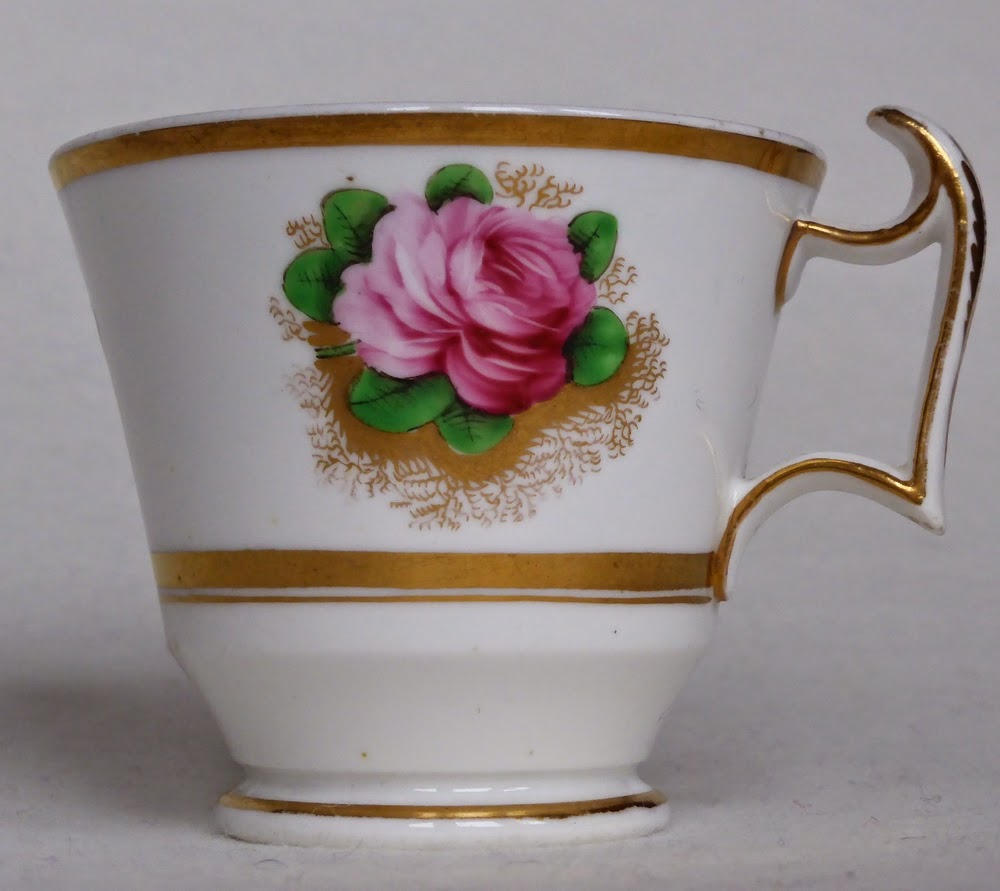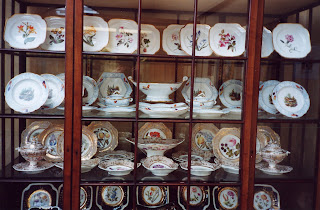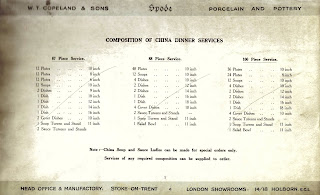![]() |
| *Monumental urn, cover and stand (gauge the size from the glimpse of an urn on a plinth, right |
Regulars to this blog will know I love pots, flowers and botanical illustration. This blog, then, is sort of for myself! But I hope you will love to look at the work of the best ceramic floral artist in the business (probably) in the 2nd half of the 19th century.
Charles Ferdinand Hürten (1821/1822-1901) was a German artist who had been trained at Cologne and then later moved to Paris. He was noted for his superb fruit, flower and foliage painting and in about 1858** he was persuaded to come to work at the Spode factory which was then
owned by W. T. Copeland. The images here feature flowers rather than fruit.
![]() |
| Round, convex plaque, study of roses |
Hürten may have been the only artist to have his own studio at Spode but this is not certain. It is also thought he was allowed to paint freely on any type of ware. There are examples in the Spode museum collection of pieces ranging from large architectural and fireplace slabs; huge, elaborate exhibition pieces;
saggar marl plaques and, at the other end of the scale, delicate flowers painted on the finest eggshell china (bone china which is so fine it resembles egg shell).
![]() |
| Vase exhibited at the International Exhibition, London 1862 |
![]() |
| Vase exhibited at the International Exhibition, London (detail) |
He was also allowed to sign his work which was in great demand. Hürten was paid an annual salary. Often the artists were paid for each piece they painted known as 'piece work'. Interestingly he reported directly to a member of the Copeland family (see below), owners of the company, rather than a manager. Such was the demand for his wares that other artists were taught to paint in his style. A vase in the Spode museum collection was for many years attributed to him but then a volunteer pointed out that it was signed by F. W. Adams!
![]() |
| Vase, details of flowers, painted by Adams in the style of Hürten |
A few years ago I carried out some research on Hürten and found further information from a number of sources. Copies of agreements between him and Spode, then owned by the Copeland family are in the
Spode archive.
On 5th June 1860 an agreement was drawn up between
'...
Mr. William Taylor Copeland Manufacturer of China, Earthenware etc at Stoke upon Trent... represented by his son Mr. Alfred Copeland... and Mr. Charles Ferdinand Hürten, painter on china, in Paris... Article 1. Mr Hürten engages himself to start within thirty days to Stoke upon Trent to place himself at the order of Mr. Copeland as painter of fruits and flowers, to work in the manufactory of china under the superintendence of Mr. Copeland or his representative during all the days of work and at the hours used at the manufactory... from 8½ in the morning [8.30am] up to 6 o'clock at night with one hour's liberty during the daytime for the dinner as is the custom of the place... Art. 3. this engagement is to last for the period of five years... Art. 4. ... 1st: payment of £21... as indemnity for Mr. Hürten, himself, his family journey and moving expenses and payment of the same agreement again for his return after the expiration of the said five years... 2nd: Annual payment of £320... for wages payable per month every last day of the month...'
Copies of this agreement were in English and in French and witnessed by Alfred Copeland and Thomas Battam (Art Director); also by Victor Taglier for Hürten.
A similar agreement was drawn up in 1870 so Hürten obviously felt happy enough to remain in post after his initial five years. His salary increased to £350 per annum and the offer of payment of £21 remained if he chose to return to Paris. This time it was witnessed by Edward Capper Copeland and Will Lambert.
![]() |
| Pair of huge 'Forty Thieves' Jars |
![]() |
| 'Forty Thieves' Jar - detail of superb painting |
![]() |
| 'Forty Thieves' Jar - detail of signature, lower right of lilies |
Correspondence in the Spode archive, donated by members of the family, reveals a little of Hürten's life. In 1860 Hürten ordered some pottery for his personal use at home and of course it came from Spode. The invoice from W. T. Copeland is dated September 26th 1860 and lists items such as '
1 tobacco jar Rockingham Gold lines, 2 blue glaze matchpots Gilt, [outside the Spode archive matchpots are often called spill vases]
2 black glaze matchpots Gilt, 2 Statuary (now known as parian ware) Sleeping Children in Cot. Hürten spent £1. 2s. 3d (about £1. 11p). At the bottom of the invoice is a list of items given as '
a Present from Mr. Copeland'. This included 'a table service for 8 persons in Honeysuckle brown, Breakfast and Tea ware and toilet ware'. At this time Hürten was living in Penkhull Terrace - walking distance from the factory in Stoke. A note shows the bill was paid in October that year.
In 1864 one of the partners in the firm, Alfred Copeland, writes to Hürten from London: '
My Dear Mr. Hürten, Accept my best and heartiest thanks for your most splendid gift. It is the most beautiful specimen of the kind I think I ever saw and I assure you my wife and I shall greatly treasure it for the kind donor's sake. I never regret the day you and I became acquainted, and I trust you may still remain in Staffordshire with us for many years. I thank you again for the beautiful and delicate Déjeuner set you have given me...'
Writing again a year later in 1865 Alfred Copeland is excited by a vase arriving in London from Stoke: '
...I cannot allow this week to close, without my acknowledging that the large Vase that has recently arrived from Stoke is truly magnificent, and we all, my father, Mr. Battam and myself are delighted with the result of your labours. I consider it the finest of your production and it does you infinite credit. You have grouped your flowers in beautiful variety and kept the colouring perfectly truthful and in good taste. The tone and feeling throughout is retained in every particular. I am pleased to say many good judges are surprised at this work and I am proud of it. I trust you are well and attempting to surpass... what you have already executed...'
Copies of letters from 1868-1871 from Hürten to members of his family in Germany are also in the Spode archive papers originally in German and translated into English. They are mainly about money, family illnesses and criticisms of lack of letters in return - just like any family! Hürten's daughter Emma married Lucien Besche another important Copeland artist. He painted a plaque of Hürten, dated January 1st 1878.
![]() |
| Hürten by Lucien Besche |
The Spode museum holds many items painted by Hürten .Whilst working as curator at the museum I received enquiries about various items painted by Hürten - all are, without exception, superbly painted pieces. The only piece I ever saw which was poorly executed is in the Spode museum collection and was not of flowers but of a cat. Very few items are actually recorded in the archive as they were often specially commissioned, unlikely to be repeated, with no need for them to be entered in the pattern books. Order books and invoice records do not survive. Occasionally oil paintings by Hürten, unconnected with the firm, turn up. Just before I left the museum I came across a thin volume which contained records of the stock of the Spode Showroom. Inside I found details of pieces on display by '
Mr. Hürten in the glass case and on the table'. This type of record is rare in the Spode archive. What a prolific man Hürten was - proved by the long lists of pieces in this book and, rarer still, these entries were annotated with the firing dates for many of the items.
![]() |
| Dessert plate, Madrid shape fully pierced, CFH monogram below pink roses |
Hürten's work was signed C. F. Hürten, CFH or C.F.H. and the company exhibited wonderful examples of it at various International Exhibitions including the Paris Exhibition in 1889 when he was in his 70th year. It is worth noting it is unusual to find his work unsigned - although often people try to attribute unsigned pieces to his hand.
He worked for Spode until the 1890s. Family sources have suggested the mid-1880s but I found sketches in an Original Sketch Book (collection no SMT 2000.287) which are dated 1887 as well as pieces he painted which are date marked 1892 such as a plaque featuring Marshal Neil roses.
![]() |
| Plaque, Marshal Neil roses (detail) 1892 |
One of the finest examples of Hürten's work is a dessert and tea service commissioned by the Prince of Wales on the occasion of his marriage to Princess Alexandra in 1863. The 196 piece service took about three years to complete. Hürten painted the orange blossom, fruit and flowers in the panels on the dessert plates with a linked AEW monogram in centre.
![]() |
| Dessert plate, Festoon Embossed shape, from service for Prince of Wales & Princess Alexandra 1863 |
![]() |
| Coffee saucer, from service for Prince of Wales & Princess Alexandra 1863 |
Other pieces in the Spode museum collection are large pressed vases, pierced desert wares, centrepieces, vases and plaques. Hürten painted wares for very many wealthy Spode customers including, as has been noted, royalty. One such customer was Mr. Macfarlane who had a new 'magnificent mansion' in Glasgow described in The Art Journal of 1875 '...th
e frieze of the heating room of the Turkish Baths, which was lined with tiles or plaques, was painted with tropical plants and flowers arranged in a masterly and effective manner....painted in sepia by Hürten...the whole of the plants represented are without exception studies from nature sketched and arranged for the purpose from the plants themselves in the magnificent conservatories of the Duke and Duchess of Devonshire at Chatsworth...'
![]() |
| Round plaque painted with poppies |
![]() |
| Vase, 18" high painted with roses |
![]() |
| Slab painted with roses (detail) with full signature |
Traditionally he is thought to have stayed at Copelands till c1897 and this seems more likely. He signed a special commemorative book for William Fowler Mountford Copeland in 1895 as the first signatory in the Painters & Gilders section and I noticed this was not in the Past Employees section.
![]() |
| Signature, commemorative book 1895 |
My research in the Spode archive has shown that not only was Hürten a superb artist and china painter he was also a designer. Evidence of his designs are in a book Prints Borders and Sprays dating from about 1867 (collection no. SMT 2000.143) and some of these went on to be developed into familiar patterns produced by transfer printing and therefore available to less wealthy customers. There are also some of his flower sketches in the archive in Original Sketch Books as well as patterns recorded in the pattern book which I believe were designed by him although not recorded as such.
![]() |
| Tray painted with dandelions and grasses c1865 |
There is no doubt that the Spode company under the Copeland family, by employing Hürten, moved into another dimension with the quality of their wares which were already famous, sought-after and award winning. Hürten, and the other premier artists, employed by the company all had their own specialism sometimes working together on one piece. Not only were they skilful as painters but their knowledge of ceramic colours, which did not show their true colour until after firing, and their ability to paint in stages, as each different colour was fired at a different temperature, means their abilities are often underestimated.
*All painted by Hürten unless otherwise stated**As mentioned in 'Spode & His Successors' by Hayden. I found that the earliest written record in the Spode archive papers suggests 1860.
Compiled and researched by Pam Woolliscroft, with thanks to Robert Copeland and the Spode archive.































































































































